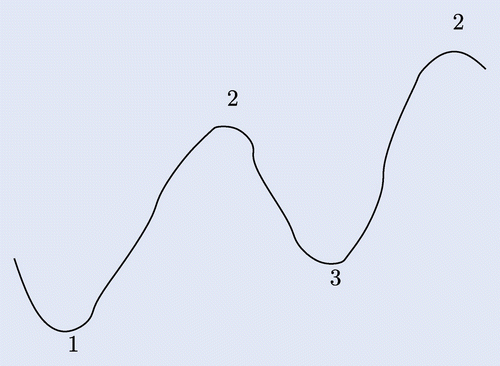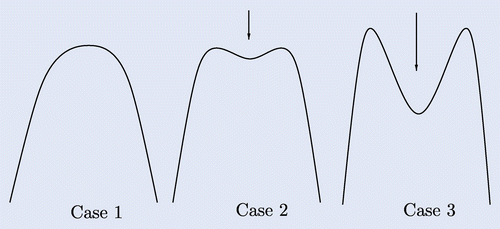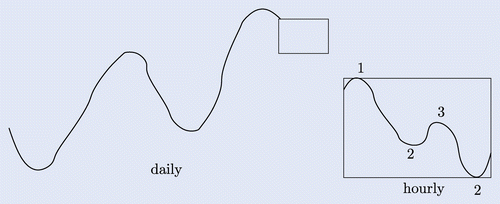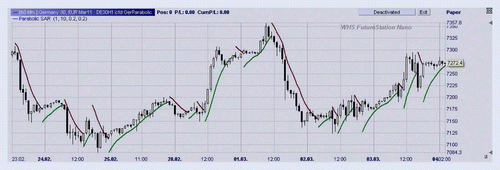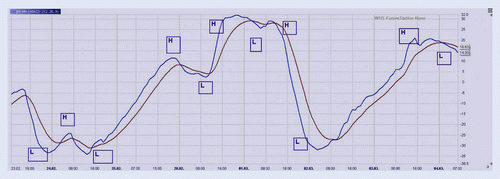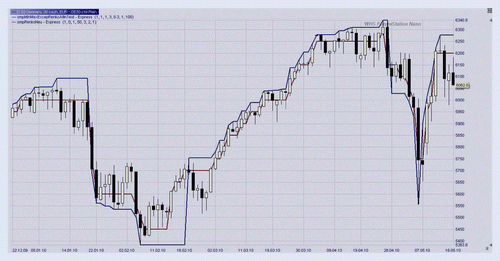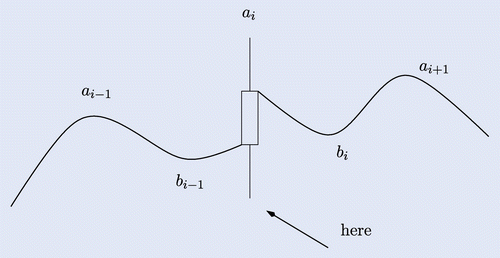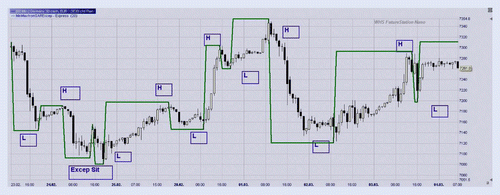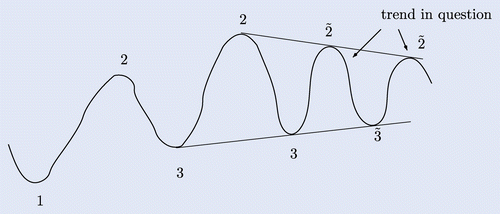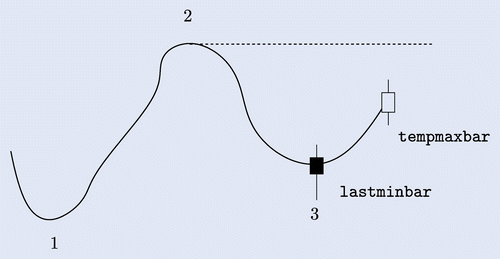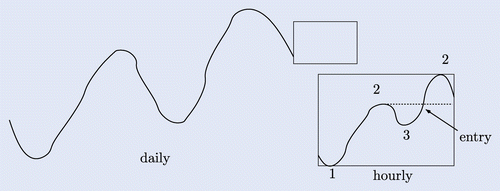Abstract
In this paper, we show how market-technical trends can be calculated automatically from underlying price processes using a stop and reverse process. The basic tool is a so called minmax process indicating all relevant minima and maxima. For the existence of the minmax process, we give a constructive proof. Several successful trend-following trading strategies can be implemented automatically based on this 1-2-3-trend indicator.
Introduction
Going back to Charles H. Dow the notion of trends is central for trading financial markets (cf. Russell Citation1981). We use the following (market-technical) trend definition:
Definition 1.1
(Market-technical Trend) A financial market is in an up-trend if the last (at least two) consecutive relevant lows as well as highs are rising. To be precise, we assume that all lows are monotonically increasing, the highs are even assumed to be strictly monotonically increasing. Similarly, one speaks of a down-trend, when the last relevant lows as well as highs are falling (with lows even strictly monotonically decreasing). If neither up- nor down-trend are present, the market is called trendless.
Remark 1.2
The above definition allows lows in an up-trend on the same level, whereas each new high in an up-trend has to be strictly above the preceding one. If in an active up-trend the next high is on the same level (or even below) the level of the last high, this is usually a bearish sign. We will denote this situation as ‘trend in question’ (cf. Definition 3.1 in Section 3 for more details)
Definition 1.3
(Movement and Correction) In an up-trend the phase between a minimum and the next (higher) maximum is called movement, while the phase between the maximum and the next (higher) minimum is called correction. In a down-trend movement and correction are defined analogously (mirrored).
Although this definition at first glance is very intuitive, it is problematic in two ways.
Firstly, the notion of relevant lows or highs is subjective to the observer. For some observers only major extrema are relevant, whereas other observers sense minor extrema also as relevant. This sensitivity problem is not only human. Even a mathematically precise definition cannot find a way around this, as figure shows.
A continuous process dents a new minimum in the left graph until the minimum can clearly be recognized as a relevant minimum next to two relevant maxima (right graph). Since this process is continuous, the decision from when on this new minimum is relevant has to be subjective.
The other problem with the definition of a relevant extremum is the time scaling. Clearly on a 10-min bar chart, much more extrema occur as relevant as on a daily or even weekly bar chart. We therefore take the position that the answer to the question, whether a market is in a trend, depends on the time scaling that we look at.
For instance, a market might be in the correction of a clear up-trend on a daily basis, while at the same time this market has a down-trend on an hourly basis (cf. figure ).
For further reference, we introduce the numbering of the relevant extrema in a trend according to e.g. Voigt (Citation2008).
Definition 1.4
(1-2-3-trend Numbering) In an up-trend the initial minimum is marked with 1, the proceeding maximum with 2 and the next (higher) minimum with 3. Further higher maxima (minima) are also numbered with 2 (3) (cf. figure ).The same numbering, but mirrored, is used for down-trends (cf. figure ). In the sequel we will often refer to point 2 or point 3, meaning the price level at these extrema.
Since an up-trend needs, besides two rising minima, also two rising maxima, the up-trend is only initialized after the minimum 3 has formed and the market rises in the sequel above the prior maximum 2. Although the new maximum has not yet been established, it is already clear that it will be above the last maximum 2, giving this level specific importance.
We summarize the proceeding:
Conclusion 1.5
A precise definition of the phases of a market (up-trend, down-trend and trendless) can be given, once
the time scaling is fixed
depending on that scaling a mathematically exact definition of alternating relevant minima and maxima is given.
As already outlined in figure , the second point in Conclusion 1.5 has to have a subjective solution, i.e. there may be several ways on how to define precisely what the alternating series of relevant minima and maxima is. Nevertheless, once this alternating ‘minmax process’ is fixed, the trend is well defined according to Definition 1.1.
The knowledge of relevant minima and maxima has furthermore importance for any sort of pattern trading. For instance, Dempster and Jones (Citation2002) considered automatic trading of channel patterns, where they had to automatically find a sequence of two minima and two maxima. Conversely to our approach, they used a simple local definition for extrema. For example, a maximum was obtained if the top of the bar in question was higher than the top of the previous r bars and at least as high as the tops of the next s bars (r and s may vary).
Also, Silagadze (Citation2011) already observed the necessity to recognize relevant minima and maxima for technical analysis of financial price series and proposed an indicator with inherent smoothing properties to do so. The extrema of this indicator, however, do not automatically yield the period and level of the extrema of the price series.
In the following section, we will outline how we intend to construct such a series of alternating minima and maxima based on a SAR process (stop and reserve process). To build the SAR process, we use the MACD indicator or Renko charts. The knowledge of a minmax process can then be used for recognizing market-technical trends according to Definition 1.1, yielding a so-called 1-2-3-trend indicator. This indicator can be used for trading trends or movements of a trend as will be shown in Section 3. An empirical study of statistical data obtained from the derived 1-2-3-trend indicator is given in Hafizogullari et al.Citation2013. Further statistical material on mechanical trading systems constructed from this trend indicator can be found in Tronnier (Citation2010), Wache (Citation2010), as well as in Hafizogullari and Platen (Citation2011) and Hafizogullari et al. (Citation2012a); Hafizogullari et al. (Citation2012b); Hafizogullari et al. (Citation2012c). Whereas Wache’s Citation2010 mechanical trading approach was based on the movement when point 2 is trespassed, Tronnier’s Citation2010 approach was to enter a trade in the trend direction when the correction has notably ended.
Hafizogullari and Platen (Citation2011) implemented counter-trend trades, based on our automatic trend recognition, whereas Hafizogullari et al. (Citation2012a); Hafizogullari et al. (Citation2012b); Hafizogullari et al. (Citation2012c) used a breakout system. The statistical data presented in the publications Hafizogullari et al. (Citation2012a), Hafizogullari et al. (Citation2012b); Hafizogullari et al. (Citation2012c), Hafizogullari and Platen (Citation2011), Tronnier (Citation2010) and Wache (Citation2010) altogether prove that our trend indicator can be applied very successfully with high significance.
Notation
In order to precisely define the relevant indicators in the following, we assume the underlying price process is given as a series with finitely many period based datawhere
is the current period,
is the period before the current period and
is the first period loaded of in total
periods. Here n is a relative period number since for a fixed bar this number changes with each new period loaded. For all other indicator series, we will use the same convention. Parameters will be denoted with a
sign, e.g.
param.
MinMax process based on SAR processes
The goal of this section is the construction of a minmax process, i.e. a series of alternating (relevant) minima and maxima of the underlying price process. Before we do so, we need some SAR process also based on the underlying price process that indicates whether the prices currently move up or down. Later in this section, we will use the up-moves to look for relevant maxima and the down-moves to look for relevant minima. Therefore, the SAR process may be viewed as tact giving for the minmax process.
If we code the SAR process in a series called Direction, we have at the current period Again, the notion ‘prices move up or down’ is subjective, but we will give in the sequel several examples of how such a SAR process might be constructed and afterwards we will show in Subsection 2.3 how the SAR process might be used to construct the minmax process. A standard example of a SAR process is the parabolic indicator of Welles J. Wilder (see figure , cf. eg. Müller and Lindner Citation2007).
MACD based SAR processes
The with figure associated MACD (moving average convergence/divergence) indicator with standard parameters (26,12,9) is given below in figure .
It appears that the market is rising when the MACD lies above the signal line (with series MACD and Signalline) and falling when the MACD is below the signal line. An upward crossing of the MACD through the signal line stands commonly as a bullish, a downward crossing as a bearish signal. Therefore, it makes sense to search for relevant highs when the MACD is above the signal line (marked with ‘H’) and for relevant lows when the MACD is below the signal line (with ‘L’), cf. again the price chart figure for these extrema. This leads us to the first MACD-based direction process (cf. figure ).(1) Not all the signals produced by the MACD (or similarly other crossing moving averages) are as clear as in figure . Sometimes MACD and signal line are for a longer period quite close, producing several ‘false signals’. To avoid the fact that the direction process produces such false signals, we ask for achange of the direction process that the distance of MACD and signal line is above some minimal threshold, i.e. for a change from
to
, we ask that
(2) and for a change from
to
that
(3) where
might be constant (
) or relative to the price process, e.g. as percentage of the close price or a multiple of the average true range of the last
spanne periods
(4) for some parameters
. The direction process that changes sign whenever (Equation2
(2) ) or (Equation3
(3) ) are fulfilled will be denoted by the series DistMACDDir depending on
and the three weights of the MACD, i.e.
Definition 2.1
(Distance MACD Direction)(5)
Sometimes MACD and signal line are quite close for some time such that the minimal threshold from above cannot be reached, although the sign of MACD-Signalline has already changed for some periods. An alternative direction process that takes care of this uses the difference of MACD and signal line in an integrated form. Letwhere
is chosen maximal such that
The associated direction process changes from
to
in case
(6) where
is constructed as in (Equation4
(4) ). Similarly, we ask for a change in the direction process from
to
that
(7) The direction process thus generated following (Equation6
(6) ) and (Equation7
(7) ) is called series IntegMACDDir:
Definition 2.2
(Integral MACD Direction)(8)
Remark 2.3
(MACD Parameters) Besides the two parameters and
spanne there are the three standard parameters
and
. In order to make the MACD Direction process faster or slower, it is sufficient for our purposes to scale these three parameters simultaneously, i.e. we use a parameter
TimeScale and set
Renko-based SAR processes
The following SAR process is based on the idea of Renko charts. In the original version, Renko charts derive from the underlying price process a chart filled with ‘bricks’ of a before fixed box size.(9) Similarly,
(10) The box size may be constant (
), or relative to the price process as percentage of the close price or multiple of the average true range, i.e.
for some parameter
. The natural direction series associated with this idea is
In figure , we see a Renko chart with
for the price process of figure .
The up-bricks are white and the down-bricks are black.
To avoid that, the thus constructed chart of bricks changes direction of the bricks too frequently, we may ask that for a change of direction, a minimum number, say of bricks need to occur before one starts to draw bricks in the new direction. Thus, in order to draw one or more up-bricks,
has to fulfill
(11) Similarly, in order to draw one or more bricks in down-direction (down-bricks)
has to fulfill
(12) Note that up-brick or down-brick in (Equation11
(11) ) and (Equation12
(12) ) are not numbers of periods, but as bricks they have upper (High(brick)) and lower (Low(brick)) boundaries. We call this direction series BodyRenkoDir, which depends on Boxsize and
RevAmount:
Definition 2.4
(Body Renko Direction)(13)
For , the series RenkoDirection and BodyRenkoDir are equal.
Since new bricks depend only on , clearly intraperiod highs or lows are ignored. For our application to construct minmax processes, this is problematic. We therefore introduce some kind of continuous Renko chart with
as before, but we refrain from drawing discrete bricks and use instead only one brick with a variable size for each direction.
(14) The resulting direction process will be denoted as RangeRenkoDir series:
Definition 2.5
(Range Renko Direction)(15)
In figure , we see a price process with current highs of the up-bricks and current lows of the low-bricks calculated according to (Equation11(11) ) and (Equation12
(12) ) (red;
) and according to (Equation14
(14) ) (blue;
). The associated direction processes based on these bricks are given in figure .
MinMax process
Now that we have constructed several SAR processes, let us outline, how such a process may be used to find relevant minima and maxima. The object that we look for is a minmax process. In the following definition, we use absolute period numbers starting at for the first period loaded up to CurrentBarIndex().
Definition 2.6
(MinMax process) A minmax process is a sequence of alternating minima and maxima with absolute period numbers:(16) The periods numbered
should be local relevant minima in the following sense
(17) and the periods numbered
should be local relevant maxima satisfying
(18) Furthermore
is maximal with the property (Equation17
(17) ), i.e. any other
with
satisfies
. Similarly,
is maximal with the property (Equation18
(18) ).
In the above definition we use the convention that e.g. High(j) refers to the absolute period number j. For instance, High(0) is the high of the first period loaded, High(1) is one of the second period and so on, or more preciselyThis is necessary, because the period of a relevant maximum does not change as new periods are loaded into the chart.
Remark 2.7
Note that the conditions for relevant extrema in (Equation17(17) ) and (Equation18
(18) ) are asymmetric.
At first glance, it would be desirable to have e.g.(19) However, this cannot be archived as the example in figure shows (minimum and maximum occur in the same period; i.e.
).
Fig. 10 Relevant extrema in (Equation17(17) ) and (Equation18
(18) ).
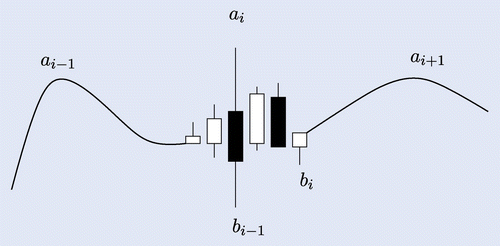
We have indicated in figure how and
have to be chosen to satisfy (Equation17
(17) ) and (Equation18
(18) ). If we wanted to satisfy (Equation19
(19) ), we would have to choose
But this is forbidden according to (Equation16
(16) ).
Let us start with the construction of such a minmax process.
No matter what SAR process we use, for simplicity in the following we will only speak of a Direction series. We begin noting that the change of the direction occurs delayed, since all our stop and reverse indicators are trend following. That means, typically, once the direction changes from to
, the market has already formed out a relevant maximum beforehand. Similarly, a relevant minimum is typically established before the direction changes back. This guides us to the following strategy:
(20) The search, e.g. for a new relevant maximum, should enable us to move the level of the recent high further up as prices proceed growing. I.e. as long as we search for the new maximum, the so-far found level of that maximum is only temporary. After we switch to searching for a new relevant minimum, however, we have to fix that former temporary maximum level once and forever. This feature is absolutely necessary. Otherwise the resulting minmax process is useless for generating trend signals, because with changing the relevant minimum and maximum levels a posteriori also the trend signals would have to be altered later on.
Before we go further into the construction of the maxima and minima, we need to point out some exceptional situations. Assume the situation of figure .
Here the direction during the last few periods is , however,
lies below the last relevant minimum found at lastminbar, which was already fixed. If we would proceed looking for a new relevant maximum according to (Equation20
(20) ), we might miss that last low as possible relevant low.
The only way to get around that dilemma, once such an exceptional situation has appeared, is to switch to searching opposite to the direction and fix the so far found temporary maximum. We therefore introduce a new seriesand
(21) yielding a new strategy:
Basic MinMax Strategy 2.8
At this point we still have to discuss how the exceptional situations may end. Assuming again the situation of figure , there are two possibilities:
The prices continue to fall and eventually the direction changes to
.
The prices start rising again and exceed eventually above the last relevant maximum that had to be fixed on entry of the exceptional situation.
For definiteness, we give the update of the Excep series once the last relevant maximum (at absolute period number lastmaxbar) and the last relevant minimum (at absolute period number lastminbar) have been found:
Definition 2.9
(Update Excep series)
If then
// exceptional process was already activeelse if
then
// check for exceptional situation
In the following we use the convention that in caseSimilarly, in case
Hence
are all absolute period numbers. Depending on whether we allow minima and maxima to occur in the same period, we get different processes of minima and maxima. This will be modelled with the parameter
Choice. We will see later that only
yields a minmax process satisfying all criteria of Definition 2.6.
In order that Definition 2.9 is well defined, we need to know what lastmaxbar and lastminbar is. These two bars can only be defined after the SAR process has finished initializing (say while initializing).
Definition 2.10
(Initial MinMax process)In both cases, we start with
, i.e.
.
Having fixed, e.g. the last minimum at lastminbar, tempmaxbar is the period of the highest high after lastminbar as long as . We therefore can now state how we update the minmax process.
Definition 2.11
(Update MinMax process)(22) where
(23)
(24)
Remark 2.12
If the seldom situation in (Equation22
(22) ) occurs, we choose tempminbar as the following period, i.e.
. Similarly, we proceed with tempmaxbar in (Equation24
(24) ).
This finishes the construction of the minmax process. The sequence of lastminbars and lastmaxbars will be denoted and
, respectively. For
, in (Equation23
(23) ), we obtain always
yielding
because e.g. in (Equation22
(22) )
and after a Status change tempminbar becomes lastminbar. Therefore, in case
, we obtain by construction
which is not enough to be a minmax process according to Definition 2.6 (cf. (Equation17
(17) ) and (Equation18
(18) )). In fact, this process may fall short to detect all relevant extrema, as is shown in figure .
Let us now have a closer look at the case . In this case
in (Equation23
(23) ) is only 1 if the relevant minima and maxima occurred at the same bar. Consequently,
is satisfied, as is necessary for a minmax process according to Definition 2.6 (cf. (Equation16
(16) )).
Again by construction for the case , we obtain
In any case we get
giving (Equation17
(17) ). (Equation18
(18) ) follows analogously. Therefore the process of alternating minima and maxima constructed in Definitions 2.9, 2.10 and 2.11 for
has all the properties for a minmax process, yielding:
Theorem 2.13
(Existence MinMax process) For every SAR process it is possible to give (in realtime) a minmax process according to Definition 2.6 that has at least as many extrema as the SAR process has sign changes.
Proof
Above, we already showed that the process we constructed with has all the properties of Definition 2.6. Every time a change of the Status series in Definition 2.11 occurred, we obtained a new extremum. By construction in (Equation21
(21) ), the number of sign changes of the Status series is at least as large as the number of sign changes of the Direction series.
Remark 2.14
With ‘in realtime’ we mean that we do decide on all extrema at the current period. Each extremum, once fixed (as lastminbar or lastmaxbar), will not be changed in retrospective. Only the temporary extrema are updated when new periods are loaded.
Definition 2.15
(minmaxvalue series) In order to be able to plot the minmax process, we define a series minmaxvalue that contains all relevant minima and maxima. Let be an absolute period number, then
(25) For
this series is not yet defined. To indicate the value of the current temporary extremum, we add
(26) Exception In case a bar contains minimum and maximum simultaneously, we want to see both of these levels. Therefore we redefine
(27) This defines a minmaxvalue series, which is able to represent all relevant minima and maxima (see figure ).
The example in figure corresponds to the MACD based direction process of figures and . Note that here two additional extrema occur due to an exceptional situation.
Automatic market-technical trends
Construction of automatic one two three
In the last section we have constructed a minmax process according to Definition 2.6. In order to generate the market-technical trend from this process, we introduce the(28) where TempExtremum is the value of the extremum associated with tempminbar or tempmaxbar, i.e.
and LastExtremum is the value of the extremum associated with lastminbar or lastmaxbar, i.e.
The other three series in (Equation28
(28) ) are similarly the values of the preceding minima and maxima.
Having these series at hand, it is easy to define a series Currenttrend(29) The definition of up-trend and down-trend was already given in Definition 1.1. A trend in question is a situation, where the formal trend definition no longer holds, but the stop level of a former trend (point 3; cf. Definition 1.4) is not yet broken, see figure .
Although here a maximum with lower (or equal) level X than the last point 2 has been found, the up-trend could quickly be continued when the prices exceed the value of X (forming a new 1-2-3). We therefore want to track these situations giving:
Definition 3.1
(Trends in question) An up-trend (down-trend) is in question, if the former high (low) of the last maximum (minimum) cannot be exceeded, but the stop level of the trend is not yet broken.
Once a trend is in question, it stays in question as long as the relevant highs are monotonically decreasing and the relevant lows are monotonically increasing (cf. figure ).
The trend numbering can be extended to trends in question as indicated in figure .
Remark 3.2
Note that the end of a trend in question can only be a continuation of the old trend at point , or, after breaking the last relevant stop level, the initialization of a new trend in the opposite direction.
The precise knowledge of the relevant extrema (Equation28(28) ) gives us the possibility to recognize situations, where trends may occur in one of the following bars. E.g. in figure no up-trend has been established yet, however, it is already clear that an up-trend will form, once the prices cross the indicated level of point 2. We therefore introduce series
Whenever trends are active or in prephase, we have knowledge of the relevant points 2 and 3 (or
and
for trends in question) giving series
Note that there are situations, where UpTrigger and DownTrigger are simultaneously meaningful (e.g. in an up-trend in question there might occur a prephase for a down-trend, see figure ).
Sometimes trends initiate without prior notice through our prephase series. More specifically, this may happen, e.g. in exceptional situations from Subsection 2.3 (see figure ), because here the change of the Direction comes too late to foresee the breakout in the opposite direction.
Another very helpful series that now can be constructed easily is(30) Adding up the Movementtrigger each time a trend is continued, we obtain the amount of the movements for each trend (series Movementnumber).
Applications of automatic one-two-three
Having the series Currenttrend (see (Equation29(29) )) at hand, it is easy to implement all kind of trend related trading ideas.
Trading Trends
A trend trader establishes a long position in an up-trend and a short position in a down-trend.
The position can usually be entered at exactly the point 2 by a stop order, because the series UpPrePhase and DownPrePhase announce possible trends and UpTrigger and DownTrigger contain the relevant point 2 level. Alternatively, one may just wait for the end of a period that triggers a new trend and open the position at the close when Currenttrend switched from 0 to 1 (long position) or (short position).
The trend trade is open as long as the trend is active. Usually this is handled with a stop at the point 3 (available through the series StopTrigger) or shortly behind the point 3. Alternatively, a trend trade may also be closed once a trend is in question (cf. Definition 3.1). Here in addition to the stop at point 3, the trade is closed when Currenttrend changes from 1 to 0.5 or from to
.
Trading Movements at Point 2
The idea of a movement trade is to use a part of the movement (cf. Definition 1.4) between the point 3 and (a new) point 2 for the trend. This movement often takes a shorter period of time as the correction (from the former point 2 to the point 3) while crossing a longer range. The typical entry into a movement trade is a stop order at the point 2 as for trend trades. Using the series Movementtrigger (see (Equation30(30) )) all the points 2 in a trend can be used for that trading ansatz.
In contrast to the trend trade, the movement trade needs a tighter stop that finishes the trade once the movement is (or seems) over. The stops used for this are all some kind of trailing stops (e.g. InOutBarsSAR of Maier-Paape (Citation2010) is a stop based on in- and outbars going back to Voigt (Citation2008)). Another suitable stop for movement trades is the ParabolicSAR (cf. Müller and Lindner Citation2007).
Elaborate statistical data on movement trades based on our method can be found in Wache (Citation2010). Hafizogullari et al. (Citation2012a); Hafizogullari et al. (Citation2012b); Hafizogullari et al. (Citation2012c) investigated breakout systems with entries from our trend indicator and small a priori fixed stops and targets.
Trading Movements out of the Correction
The idea here is to start the trade of the movement earlier than at point 2. One possibility is to start the trade of the movement once a new point 3 has formed in an already active trend that is currently in a correction. With our methods, this is clear when a change of Status (cf. (Equation21(21) )) has occurred. If we use a SAR process based on Range Renko Direction (see (Equation15
(15) )), this can even be decided intraperiod due to the decision rules in (Equation14
(14) ). The initial stop lies at the new point 3. After the point 2 has been exceeded, one has to switch to a trailing stop as before (e.g. InOutBarsSAR or similar). There are much more entry rules that make sense to enter a trade in the correction (e.g. reversal candles, breaking of a trend line, forming of a trend in a finer time scale, Fibonacci levels), some of which have been successfully backtested with our 1-2-3-trend indicator (see Tronnier Citation2010). Wache (Citation2010) also used multi- scale 1-2-3 for trading movements (see figure ).
Other applications
Another application for trading counter-trends can be found in Hafizogullari and Platen (Citation2011), which is based on our 1-2-3-trend indicator and InOutBarsSAR as well.
Conclusion
The discussion following figure made clear that any definition of market-technical trends is always subjective, because the relevant minima and maxima are subjective. We nevertheless gave a clear and precise derivation of a minmax process (containing all relevant minima and maxima) only based on the prior knowledge of a SAR process.
We furthermore indicated how the minmax process may be used to implement all kind of trend following trading styles automatically. Further work and work in progress concerns empirical statistics on the 1-2-3-trend indicator, which may help to characterize markets and do comparisons between different markets (see Hafizogullari et al.Citation2013).
Acknowledgments
The author wishes to thank Michael Voigt, Yasemin Hafizogullari, and Andreas Platen for helpful discussions, as well as Frieder Paape for many hints concerning the algorithmic details.
References
- Dempster, M.A.H. and Jones, C.M., Can channel pattern trading be profitably automated? Eur. J. Finance, 2002, 8, 275–301.
- Hafizogullari, Y., Maier-Paape, S. and Platen, A., 1-2-3 Ausbrüche, Coverstory TRADERS’ 01/2012, 10–16.
- Hafizogullari, Y., Maier-Paape, S. and Platen, A., 1-2-3 Breakouts, Coverstory TRADERS’ Online 02/2012, 6–11. Available online at: http://tradersonline-mag.com/01_ezine/01_traders/en/2012/02/index.html
- Hafizogullari, Y., Maier-Paape, S. and Platen, A., Breakoutpunkte zu markttechnischen Trends, TRADERS’ 02/2012, 50–54.
- Hafizogullari, Y., Maier-Paape, S. and Platen, A., Empirical study of the 1–2-3-trend indicator, preprint, 2013. Available online at: http://www.instmath.rwth-aachen.de/preprints
- Hafizogullari, Y. and Platen, A., Countertrendhandel mit Außenstäben, Beitrag VTAD Award, 2011. Available online at: http://www.vtad.de/forschungsarbeiten
- Maier-Paape, S., InOutBarsSAR, 2010. Available online at: http://www.vtad.de/forschungsarbeiten
- Müller, Th. and Lindner, W., Das große Buch der technischen Indikatoren, 2007 (TM Börsenverlag AG). Available online at: http://www.boersenverlag.de
- Russell, R., The Dow Theory Today, 1981 (Fraser). Available online at: http://www.amazon.com/The-Theory-Today-Richard-Russell/dp/1607965186
- Silagadze, Z.K., Moving Mini-Max – a new indicator for technical analysis. IFTA J., 2011, 11, 46–49.
- Tronnier, M., Automatisierter Korrekturhandel, Bachelor-Arbeit, RWTH Aachen, 2010. Available online at: http://www.vtad.de/forschungsarbeiten
- Voigt, M., Das große Buch der Markttechnik, 4th edition, 2008 (FinanzBuch Verlag). Available online at: http://www.m-vg/finanzbuchverlag
- Wache, K., Automatisierter Bewegungshandel, Bachelor-Arbeit, RWTH Aachen, 2010. Available online at: http://www.vtad.de/forschungsarbeiten

